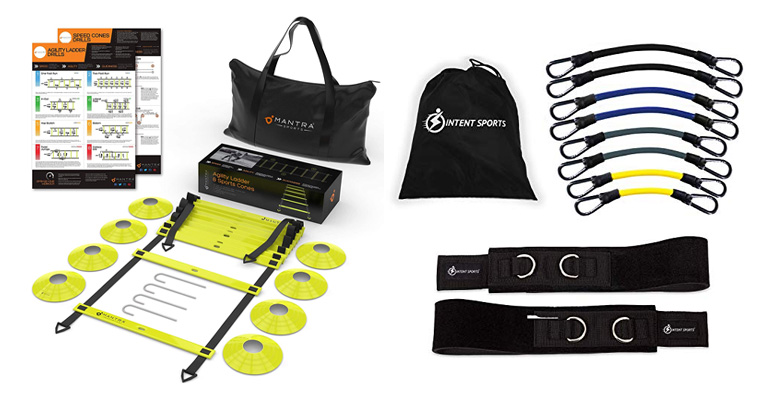The world of football agility training, where speed, agility, and quick reflexes are the keys to success on the field. In this fast-paced sport, mastering agility is essential for evading defenders, making sharp cuts, and executing precise movements.
Get ready to discover a range of dynamic drills and innovative training equipment that will help you take your agility to new heights.
From ladder drills that improve footwork and coordination to cone drills that enhance change of direction and reaction time, our comprehensive training program covers all aspects of agility.
So, lace up your cleats, grab your gear, and prepare to elevate your game. With the right football agility trainers, drills, and equipment, you’ll develop the agility needed to outmaneuver opponents and make game-changing plays on the football field.
What Are Football Agility Trainers and Training Drills in Football?
Agility training for football is a specific type of training that focuses on improving an athlete’s ability to change direction quickly, maintain balance, and react swiftly. It aims to enhance an athlete’s agility, speed, coordination, and overall athleticism, which are crucial skills in football.
Agility training typically involves a variety of exercises and drills that simulate game-like movements and scenarios. These exercises often include ladder drills, cone drills, shuttle runs, agility hurdles, and reaction drills.
The training may also incorporate ladder footwork, lateral movements, quick changes of direction, and acceleration and deceleration techniques.
The primary goals of agility training in football are to improve an athlete’s ability to evade opponents, make sharp cuts, accelerate rapidly, and maintain control while changing direction.
It helps football players become more elusive, agile, and responsive on the field, enabling them to outmaneuver opponents, create scoring opportunities, and enhance overall performance.
Best Agility Training Drills for Speed

Agility training drills are an essential part of any football player’s training regimen. They help improve quickness, change of direction, and overall agility on the field.
Here are 8 most effective agility training drills that can be incorporated into a football player’s workout routine:
Ladder Drills
Ladder drills are a popular choice for agility training as they focus on footwork, coordination, and quickness.
Set up an agility ladder on the ground and perform various movements through the ladder, such as high knees, lateral shuffles, in-and-outs, and quick feet. These drills help improve foot speed, agility, and body control.
Cone Drills
Cone drills are versatile and can be customized to target specific movements required in football. Set up cones in different patterns, such as the T-drill, 5-10-5 drill, or the 3-cone drill (also known as the “L-drill”).
These drills involve sprinting, changing direction, and accelerating, simulating game-like movements. They help improve agility, acceleration, and the ability to change direction quickly.
Shuttle Runs
Shuttle runs are excellent for improving acceleration, deceleration, and change of direction. Set up two cones approximately 10-20 yards apart.
Start at one cone, sprint to the other cone, touch it, and then sprint back to the starting cone. Repeat this back-and-forth movement for a set number times.
Focus on explosiveness, quick changes of direction, and maintaining proper form throughout the drill.
Reaction Drills
Reaction drills are designed to improve an athlete’s ability to react quickly to visual or auditory cues, which is crucial in football. One example is the “Mirror Drill.” Stand facing a partner, and have them perform random movements.
Your goal is to mirror their movements as quickly and accurately as possible. This drill helps improve reaction time, coordination, and the ability to read and react to opponents on the field.
Box Drill
The box drill is an excellent drill for improving quickness, change of direction, and lateral movement. Set up four cones in a square shape, with each cone about 5-10 yards apart.
Start at one cone and sprint diagonally to the next cone, shuffle laterally to the next cone, backpedal to the next cone, and finally shuffle laterally back to the starting cone. Repeat this sequence for a set number of repetitions or times.
Zigzag Cone Drill
The zigzag cone drill focuses on improving agility, cutting ability, and body control. Set up a series of cones in a zigzag pattern, about 2-3 yards apart. Start at one end and sprint diagonally to the first cone, then quickly change direction and sprint diagonally to the next cone, and so on.
Focus on sharp cuts, maintaining balance, and accelerating out of each turn. Repeat the drill for multiple sets.
T-Drill
The T-drill is a classic agility drill that helps improve acceleration, change of direction, and overall agility. Set up cones in the shape of a “T,” with the top of the T being the starting point and the base of the T being the finish line.
Start at the top of the T, sprint forward to the middle cone, shuffle laterally to the left cone, shuffle back to the middle cone, and then shuffle laterally to the right cone. Finish by backpedaling to the base of the T. Repeat for multiple sets, focusing on speed and precision.
Agility Hurdles
Agility hurdles are a great way to improve footwork, coordination, and quickness. Set up a series of small hurdles in a straight line, about 1-2 feet apart. Start at one end and perform quick, high knee steps over each hurdle, maintaining a fast pace.
Focus on staying light on your feet, minimizing ground contact time, and maintaining proper form throughout the drill. Repeat for multiple sets or time intervals.
When incorporating these drills into your training routine, it’s important to focus on proper technique, speed, and intensity. Start with a proper warm-up to prepare your muscles and joints for agility training.
Gradually increase the difficulty and intensity of the drills as you progress. Remember to maintain good form, stay light on your feet, and always prioritize safety to prevent injuries.
It’s beneficial to mix up your training routine to challenge different muscle groups and movement patterns. Consulting with a qualified coach or trainer can help you design a comprehensive agility training program tailored to your specific needs and goals as a football player.
Agility Trainers Equipment List

When it comes to agility training drills, there are several types of equipment that can be used to enhance the effectiveness of the drills. Here are some common equipment options used by trainers for agility training:
Agility Ladder
An agility ladder is a ladder-like device made of flat rungs connected by straps. It is laid out on the ground, and athletes perform various footwork drills by stepping in and out of the ladder rungs.
Agility ladders help improve foot speed, coordination, and quickness.
Cones
Cones are versatile and widely used in agility training. They can be set up in different patterns to create drills that focus on change of direction, acceleration, and deceleration.
Cones are lightweight, portable, and inexpensive, making them a popular choice for agility training.
Agility Hurdles
Agility hurdles are small, adjustable hurdles that can be used to improve footwork, coordination, and quickness. They can be set at different heights to challenge athletes at various skill levels.
Agility hurdles are particularly useful for developing explosive power and agility in movements such as jumping, cutting, and lateral shuffling.
Reaction Balls
Reaction balls are small, rubber balls with uneven surfaces that cause them to bounce unpredictably. They are used in reaction drills to improve hand-eye coordination, reaction time, and agility.
Athletes react to the ball’s unpredictable bounces by quickly moving and catching it.
Speed Chutes
Speed chutes are parachute-like devices that attach to an athlete’s waist or back. They provide resistance during sprinting, forcing the athlete to exert more effort and power to overcome the resistance.
Speed chutes are effective for developing acceleration, stride length, and lower body strength.
Agility Rings
Agility rings are circular rings made of lightweight material that can be placed on the ground. Athletes perform various footwork drills by stepping in and out of the rings, improving their agility, balance, and coordination.
Reaction Lights
Reaction lights are electronic devices that consist of a series of lights that randomly turn on and off. Athletes react to the lights by quickly touching or pressing them. Reaction lights are used to improve reaction time, hand-eye coordination, and decision-making skills.
These are just a few examples of equipment commonly used in agility training drills. The specific equipment used may vary depending on the training goals, available resources, and individual preferences.
FAQs
How often should I incorporate agility training drills into my football training routine?
The frequency of agility training drills can vary depending on your overall training program and goals. However, it is generally recommended to include agility training at least 2-3 times per week to see noticeable improvements.
Can agility training drills help prevent injuries in football?
Yes, agility training drills can help reduce the risk of injuries in football. By improving agility, balance, and body control, athletes can better navigate the field, change direction safely, and react to opponents or game situations. Stronger and more agile muscles and joints can also help absorb impact and reduce the likelihood of strains, sprains, and other common football injuries.
Are agility training drills suitable for all ages and skill levels?
Yes, agility training drills can be adapted to suit athletes of all ages and skill levels. The intensity, complexity, and volume of the drills can be adjusted based on individual capabilities.
Can agility training drills improve speed in football?
While agility training primarily focuses on quickness, change of direction, and body control, it can indirectly improve speed in football. By enhancing an athlete’s ability to accelerate and change direction efficiently, agility training can contribute to overall speed improvements.
How long does it take to see results from agility training drills?
The time it takes to see results from agility training drills can vary depending on several factors, including the individual’s starting point, training frequency, intensity, and consistency. With regular and dedicated practice, athletes can typically start noticing improvements in their agility, quickness, and change of direction within a few weeks.
Final Words
Football agility trainers, drills, and equipment are game-changers for athletes looking to enhance their performance on the field. By incorporating a variety of agility drills and utilizing specialized training equipment, you can enhance your speed, quickness, and overall agility.
The dynamic nature of football requires athletes to be able to change direction rapidly, react quickly to game situations, and maintain precise footwork.
So, if you’re a beginner looking to improve your foundational agility, investing time and effort into agility training will undoubtedly pay off.
Remember, agility is not just a physical attribute but also a mental one. Stay focused, stay determined, and let your newfound agility propel you toward success. Get ready to leave your opponents in awe as you unleash your football agility and make your mark on the game.







